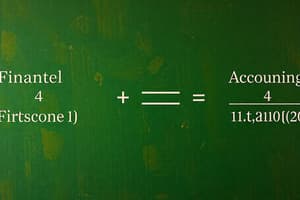Podcast
Questions and Answers
What is the Weighted Average Cost of Capital (WACC)?
What is the Weighted Average Cost of Capital (WACC)?
- Interest Payments / Total Capital
- (Cost of Equity x % Equity in Cap Structure) + (Weighted Average Cost of Debt x % of Debt in Cap Structure) (correct)
- Total Capital / Total Debt
- Cost of Equity + Cost of Debt
What is the formula for the Weighted Average Cost of Debt?
What is the formula for the Weighted Average Cost of Debt?
Effective Annual Interest Payments / Debt Outstanding
What does the After Tax Cost of Debt formula represent?
What does the After Tax Cost of Debt formula represent?
Pretax Cost of Debt x (1 - Tax Rate)
What is the formula for the Cost of Preferred Stock?
What is the formula for the Cost of Preferred Stock?
How is CAPM (Cost of Retained Earnings) calculated?
How is CAPM (Cost of Retained Earnings) calculated?
What is DCF?
What is DCF?
What does BYRP (Cost of Retained Earnings) stand for?
What does BYRP (Cost of Retained Earnings) stand for?
What is the Growth Rate formula?
What is the Growth Rate formula?
What is the formula for Return on Investment?
What is the formula for Return on Investment?
How is Return on Assets calculated?
How is Return on Assets calculated?
What does Return on Equity (ROE) indicate?
What does Return on Equity (ROE) indicate?
What is the Total Debt to Capital Ratio?
What is the Total Debt to Capital Ratio?
What does the Debt to Equity Ratio represent?
What does the Debt to Equity Ratio represent?
How is the Times Interest Earned Ratio calculated?
How is the Times Interest Earned Ratio calculated?
What is the Current Ratio formula?
What is the Current Ratio formula?
What is the Quick Ratio formula?
What is the Quick Ratio formula?
How is the Cash Ratio calculated?
How is the Cash Ratio calculated?
What does Cash Conversion Cycle measure?
What does Cash Conversion Cycle measure?
What is the Inventory Conversion Period formula?
What is the Inventory Conversion Period formula?
What does the Inventory Turnover formula represent?
What does the Inventory Turnover formula represent?
How is the Receivable Conversion Period calculated?
How is the Receivable Conversion Period calculated?
What is the formula for AR Turnover?
What is the formula for AR Turnover?
How is the Payable Deferral Period calculated?
How is the Payable Deferral Period calculated?
What is the AP Turnover formula?
What is the AP Turnover formula?
What does Working Capital Turnover represent?
What does Working Capital Turnover represent?
How is Working Capital calculated?
How is Working Capital calculated?
What is the formula for Reorder Point?
What is the formula for Reorder Point?
What is Economic Order Quantity (EOQ)?
What is Economic Order Quantity (EOQ)?
What does the APR of Quick PMT Discount formula represent?
What does the APR of Quick PMT Discount formula represent?
What is Days Sales Outstanding?
What is Days Sales Outstanding?
How is the Present Value of Perpetuity calculated?
How is the Present Value of Perpetuity calculated?
What does the Price to Earnings Ratio represent?
What does the Price to Earnings Ratio represent?
How do you calculate the Trailing P/E Ratio?
How do you calculate the Trailing P/E Ratio?
What is the PEG Ratio formula?
What is the PEG Ratio formula?
What is Valuing Equity formula?
What is Valuing Equity formula?
What does the Price to Sales Ratio indicate?
What does the Price to Sales Ratio indicate?
How is Valuing Equity with Price to Sales calculated?
How is Valuing Equity with Price to Sales calculated?
What is the Price to Cash Flow Ratio?
What is the Price to Cash Flow Ratio?
How do you calculate the Price to Book Value?
How do you calculate the Price to Book Value?
What does the Profitability Index measure?
What does the Profitability Index measure?
What is the formula for PV of 1$?
What is the formula for PV of 1$?
How is PV of Annuity calculated?
How is PV of Annuity calculated?
What does Prime Cost represent?
What does Prime Cost represent?
What is Conversion Cost?
What is Conversion Cost?
How is Overhead Rate calculated?
How is Overhead Rate calculated?
What does Applied OH refer to?
What does Applied OH refer to?
What is the formula for Weighted Average EQ Units?
What is the formula for Weighted Average EQ Units?
How do you calculate FIFO EQ Units?
How do you calculate FIFO EQ Units?
What does the Return on Investment % represent?
What does the Return on Investment % represent?
What is Investment Turnover?
What is Investment Turnover?
How is Return on Assets calculated?
How is Return on Assets calculated?
What does Return on Equity represent?
What does Return on Equity represent?
How is Net Profit Margin calculated?
How is Net Profit Margin calculated?
What does Asset Turnover measure?
What does Asset Turnover measure?
What is Financial Leverage?
What is Financial Leverage?
What does Dupont ROE represent?
What does Dupont ROE represent?
What is Tax Burden?
What is Tax Burden?
What does Interest Burden indicate?
What does Interest Burden indicate?
How is EBIT Margin calculated?
How is EBIT Margin calculated?
What is the Extended Dupont ROE Formula?
What is the Extended Dupont ROE Formula?
What does Residual Income indicate?
What does Residual Income indicate?
What is Required Return?
What is Required Return?
How is Economic Value Added calculated?
How is Economic Value Added calculated?
What does Return on Sales measure?
What does Return on Sales measure?
How is Real GDP calculated?
How is Real GDP calculated?
What does the Multiplier Effect represent?
What does the Multiplier Effect represent?
How is the Consumer Price Index calculated?
How is the Consumer Price Index calculated?
What does Change in Real GDP represent?
What does Change in Real GDP represent?
What is the Real Interest Rate formula?
What is the Real Interest Rate formula?
How is Price Elasticity of Demand calculated?
How is Price Elasticity of Demand calculated?
What is Price Elasticity of Supply?
What is Price Elasticity of Supply?
What does Cross Elasticity of Demand indicate?
What does Cross Elasticity of Demand indicate?
How is Income Elasticity of Demand calculated?
How is Income Elasticity of Demand calculated?
What is the Absorption Approach to accounting?
What is the Absorption Approach to accounting?
What does the Contribution Approach show?
What does the Contribution Approach show?
What is the Unit Contribution Margin?
What is the Unit Contribution Margin?
What does the CM Ratio represent?
What does the CM Ratio represent?
How do you determine the Difference Between Variable and Absorption costing?
How do you determine the Difference Between Variable and Absorption costing?
What is the Break Even Per Unit formula?
What is the Break Even Per Unit formula?
What is the Breakeven Point in Dollars?
What is the Breakeven Point in Dollars?
How do you calculate Sales (Units) Needed to Break Even?
How do you calculate Sales (Units) Needed to Break Even?
What is the Sales Dollar BE Point for Target Profit?
What is the Sales Dollar BE Point for Target Profit?
How is the Sales Price Per Unit for Target Profit calculated?
How is the Sales Price Per Unit for Target Profit calculated?
What does Margin of Safety indicate?
What does Margin of Safety indicate?
How is Margin of Safety % calculated?
How is Margin of Safety % calculated?
What is the Target Cost formula?
What is the Target Cost formula?
How is Operating Cash Flow calculated?
How is Operating Cash Flow calculated?
What is Net Profit Margin?
What is Net Profit Margin?
How is Operating Margin calculated?
How is Operating Margin calculated?
What is Budgeted Production?
What is Budgeted Production?
What is Standard Direct Cost?
What is Standard Direct Cost?
How is Standard Indirect Cost calculated?
How is Standard Indirect Cost calculated?
What does DM Price Variance indicate?
What does DM Price Variance indicate?
What is DM Qty Variance?
What is DM Qty Variance?
What does DL Rate Variance indicate?
What does DL Rate Variance indicate?
What is DL Efficiency Rate?
What is DL Efficiency Rate?
What does VOH Rate (Spending) Variance indicate?
What does VOH Rate (Spending) Variance indicate?
What is VOH Efficiency Variance?
What is VOH Efficiency Variance?
Flashcards are hidden until you start studying
Study Notes
Financial Metrics and Formulas
- Weighted Average Cost of Capital (WACC): Formula = (Cost of Equity x % Equity) + (Weighted Avg. Cost of Debt x % Debt).
- Weighted Average Cost of Debt: Effective Annual Interest Payments / Total Debt Outstanding.
- After Tax Cost of Debt: Pretax Cost of Debt adjusted for tax = Pretax Cost of Debt x (1 - Tax Rate).
- Cost of Preferred Stock: Preferred Stock Dividends divided by Net Proceeds from Preferred Stock.
Cost and Return Calculations
- CAPM (Cost of Retained Earnings): Formula = Risk-Free Rate + (Beta x (Market Return - Risk-Free Rate)).
- Discounted Cash Flow (DCF): Formula = Expected Dividend at Year End / Current Market Value of Common Stock.
- Growth Rate: Calculated as Retention Ratio x Return on Investment.
Profitability Ratios
- Return on Investment (ROI): Net Income divided by Average Invested Capital.
- Return on Assets (ROA): Net Income divided by Total Assets.
- Return on Equity (ROE): Net Income divided by Shareholders' Equity.
Leverage and Coverage Ratios
- Total Debt to Capital Ratio: Total Debt divided by Total Capital (liabilities + equity).
- Debt to Equity Ratio: Total Debt divided by Total Equity.
- Times Interest Earned Ratio: Earnings Before Interest and Taxes (EBIT) divided by Interest Expense.
Liquidity Ratios
- Current Ratio: Current Assets divided by Current Liabilities.
- Quick Ratio: (Cash + Marketable Securities + Receivables) divided by Current Liabilities.
- Cash Ratio: Cash plus Cash Equivalents divided by Current Liabilities.
Operating and Efficiency Metrics
- Cash Conversion Cycle: Inventory Conversion Period + Receivable Conversion Period - Payable Deferral Period.
- Inventory Conversion Period: 365 days divided by Inventory Turnover.
- Receivable Conversion Period: 365 days divided by Accounts Receivable Turnover.
- Payable Deferral Period: 365 days divided by Accounts Payable Turnover.
Sales Metrics
- Working Capital Turnover: Sales divided by Average Working Capital.
- Return on Sales: Net Income divided by Sales.
- Net Profit Margin: Net Income divided by Sales.
Breakeven Analysis
- Break Even Per Unit: Total Fixed Costs divided by Contribution Margin per Unit.
- Breakeven Point in Dollars: Total Fixed Costs divided by Contribution Margin % or Unit Price x Breakeven Units.
- Margin of Safety: Total Sales minus Breakeven Sales.
Investment Valuations
- Price to Earnings Ratio (P/E): Stock Price divided by Expected EPS.
- Price to Book Value: Stock Price divided by Book Value of Common Stock.
- Price to Cash Flow Ratio: Stock Price divided by Expected Cash Flow in One Year.
Advanced Valuation Concepts
- Economic Value Added (EVA): Net Operating Profit After Tax minus Required Return (investment x WACC).
- Residual Income: Net Income minus Required Return.
- Dupont Analysis of ROE: Breaks down into Net Profit Margin, Asset Turnover, and Financial Leverage.
Variance Analysis
- Direct Material Price Variance: Actual Quantity Purchased x (Actual Price - Standard Price).
- Direct Labor Rate Variance: Actual Hours Worked x (Actual Rate - Standard Rate).
- Variable Overhead Rate Variance: Actual Hours x (Actual Rate - Standard Rate).
Production and Cost Analysis
- Budgeted Production: Budgeted Sales plus Desired Ending Inventory minus Beginning Inventory.
- Standard Direct Cost: Standard Price multiplied by Standard Quantity.
- Standard Indirect Cost: Standard Application Rate multiplied by Standard Quantity.
Economic Indicators
- Real GDP: Nominal GDP divided by GDP Deflator x 100.
- Consumer Price Index (CPI): (Current Cost of Market Basket / Base Year Cost) x 100.
- Real Interest Rate: Nominal Interest Rate minus Inflation.
Economic Formulas
- Multiplier Effect: 1 divided by (1 - Marginal Propensity to Consume).
- Price Elasticity of Demand: % Change in Quantity Demanded divided by % Change in Price.
- Cross Elasticity of Demand: % Change in Quantity Demanded of Good A divided by % Change in Price of Good B.
Studying That Suits You
Use AI to generate personalized quizzes and flashcards to suit your learning preferences.




